- Home
- So Many Species
- W. filifera
Filifera Palm Tree
Filifera Palm Trees are the only palm native to the Western United States.
This fan palm's scientific name is Washingtonia filifera. Originating in Southern California and Western Arizona. Nearby to arroyos (intermittent streams), and oases. But in today's world, it's gone beyond that.
We're here to help you go beyond that as well!
At Mission: Palm Trees
We help palm lovers simplify their searches and ease their concerns. Our articles are meant to inform, while having fun, easily Finding What You Want or Need. We eliminate unnecessary shoptalk & tiring research. We Discover For You!
Contents
History of Washingtonia Filifera:
From Native Roots to Modern Landscapes
Besides Arizona and California, this sturdy palm tree is also native to northeastern Baja California, Mexico.
It's gotten several common names. Most often called the California Fan Palm and the Desert Fan Palm. Named for the dead fronds along the trunk, it's also called the Petticoat Palm.
Its evolution developed the strength to succeed in those hot, dry, desert climates. Now its become favored by residents of states and countries outside its native locations. Like Texas and More Places.
It's living proof of nature’s skillfulness in making adjustments.
Unique Characteristics of Washingtonia Filifera
The Washingtonia filifera palm tree is one of those singled out as a palm away from those growing in the steamy tropics.
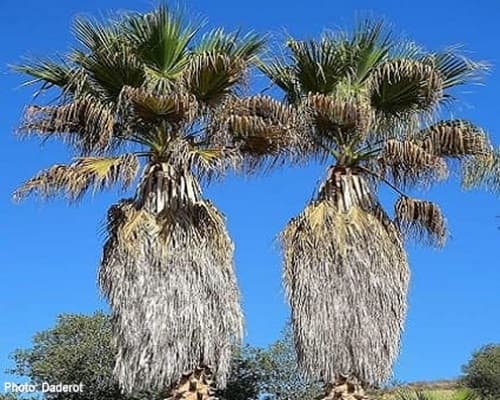 Twin filiferas in their skirts in San Luis Obispo California
Twin filiferas in their skirts in San Luis Obispo CaliforniaIdentifying the filifera
Besides this palm's perseverance, it has a few Palm Construction points (one literally!) to be aware of.
- The first thing is noticing it's fan-shaped leaves. The pinnate fronds, as wide as 8ft/2.4m. Looking silvery-green, yellow-green or gray-green.
- Adding more frond length, petioles (stems) from trunk to blade (the fan section) span 6ft/1.8m.
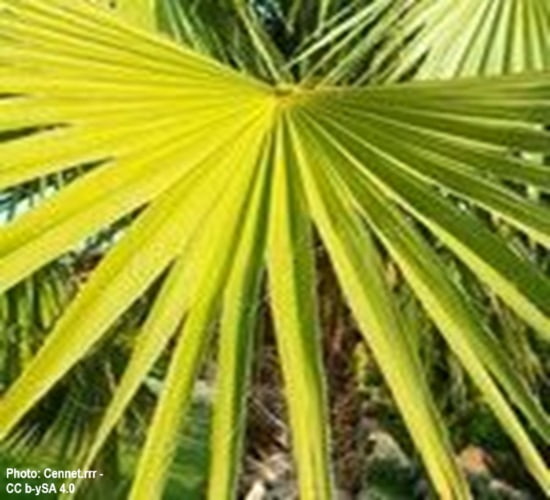 Underside View: Induplicate Segments - Upward V-Shaped
Underside View: Induplicate Segments - Upward V-Shaped- Past maturity, filifera palm tree growth speeds up some. Gaining about 3ft/0.9m yearly.
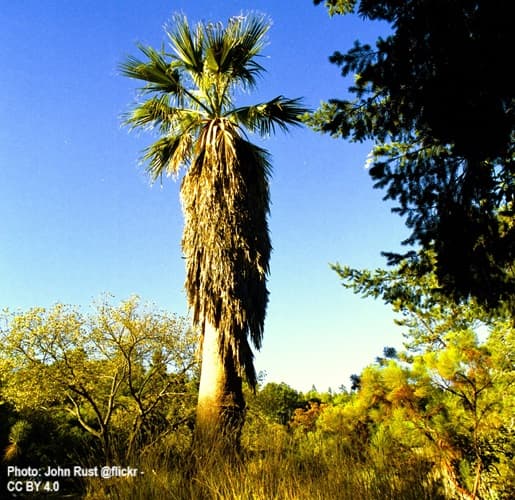 Getting Taller, Eventually Reaching 60ft/18.3m of Loft
Getting Taller, Eventually Reaching 60ft/18.3m of Loft- Past seedling stage, fronds develop prickly teeth at the edges.
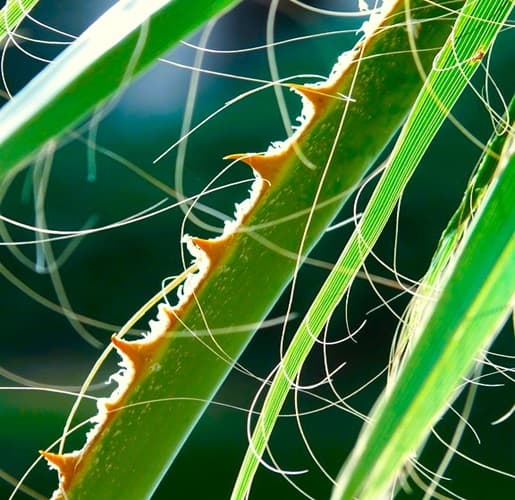 Very Pointy - Use Caution!
Very Pointy - Use Caution!Its trunk gets to 4ft/1.2m thick & mighty. Usually grayish brown.
What's relatively different about its trunk from most palms, is the covering it keeps. A blanket of packed, old dead fronds. Giving that nickname: Petticoat Palm.
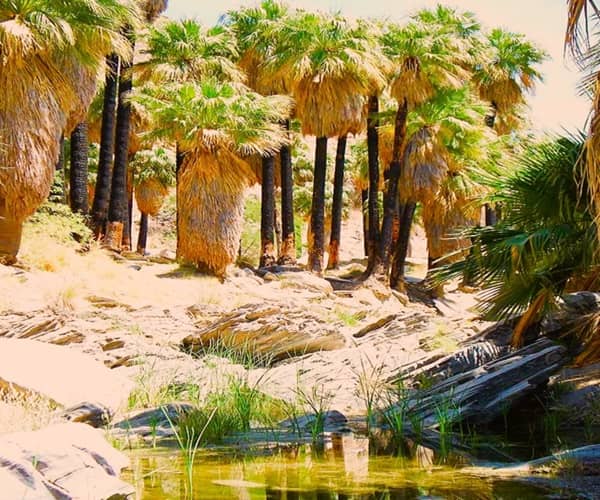 Loving the water access at Santa Rosa in the San Jacinto Mountains.
Loving the water access at Santa Rosa in the San Jacinto Mountains.Looking upward at such a palm, you'd feel the grandeur of it!
Our Latest
-
How Many Palms Are There? Discover Global Species
Curious about how many palms are there? We'll show you the astonishing diversity of palm species that flourish in diverse habitats.
What Else Helps filifera Identification?
Other traits help identify it.
The wide, nearly circular fronds have dips called segments. These openings enter about halfway into the leaf.
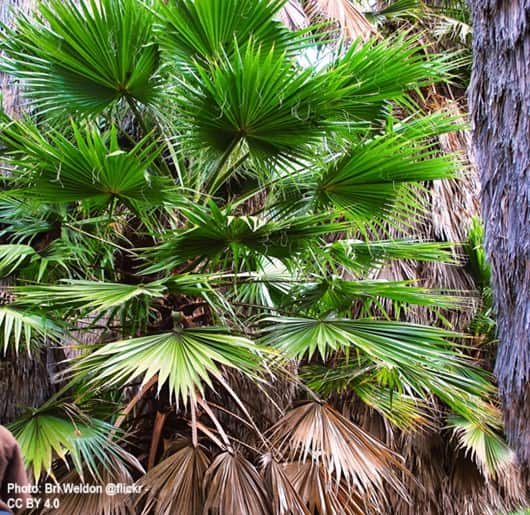 Segments into the fronds are noticeable on this younger filifera.
Segments into the fronds are noticeable on this younger filifera.The lengthy Inflorescence Branch arrives in spring to flower. Off-white flowers bring the brown/black fruit. This part of the palm, the infructescence, heavily droops downward.
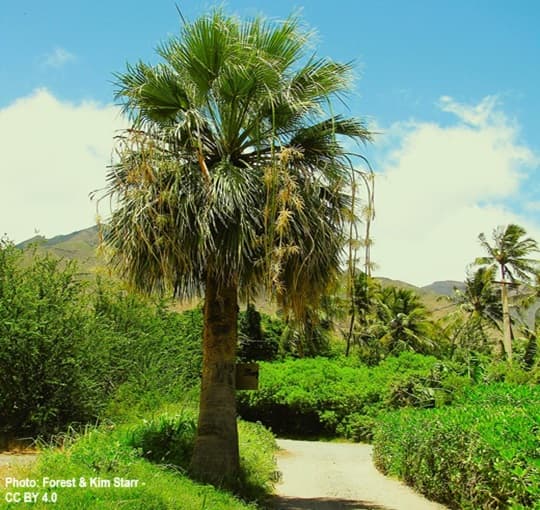 Flowering Inflorescences Grow Long From Mid-Crown
Flowering Inflorescences Grow Long From Mid-CrownComparing the two Washingtonia Species
The other Washingtonia is W.robusta.
Many wonder the difference between these two. As both are native to similar climates. And they're both fan palms.
But robusta fronds are shorter, making a more compact crown.
What's really different is the trunk:
- The robusta, or Mexican fan palm, is much taller. Think of those lofty Palms of Los Angeles growing sky high!
- Their trunks are much thinner.
Ideal Growing Conditions for Washingtonia filifera
The filifera palm's ideal climate is arid. Mediterranean climates are perfect, too. But it's adaptable to a certain degree. It is found in subtropical, humid regions, like Southern Texas.
The recommended USDA Hardiness Zones are 7-11 for dryer places, and in wetter climes 8-11. If you live where there's mild winters, rarely getting below freezing, your yard might be fully suitable.
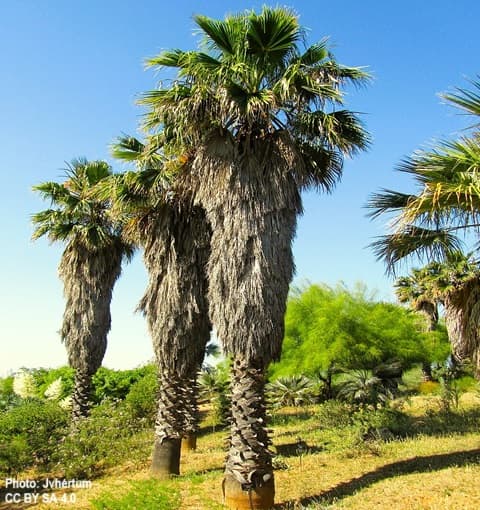 In Jardi Botanic, Barcelona Spain's Mediterranean Climate
In Jardi Botanic, Barcelona Spain's Mediterranean ClimateW. filifera's Cold Resistance
Washingtonia filifera is cold resistant once it's well beyond seedling stage. Some mature filiferas have not been touched by temps as low as 20oF/-6.7oC.
Some have even survived with freezing to -11oF/-23.9oC. Survived is the key word - as they probably Experienced Cold Damage. And that low temp must've not lasted long.
If that's a possibility for you on occasion, be aware of Frost Protective Measures.

Tips for Cultivating Washingtonia Filifera in Your Garden
Consider Your Own Microclimate Conditions
How Much Sunlight?
Sun is the prime need for a happy filifera palm tree. Remember it's native lands, in sun-drenched deserts. If you like those sunny days, you'll get along fine with W.filifera.
What Watering Schedule Would it Like?
Once it's fully established, Washingtonia filifera palms are quite drought-tolerant. When young though, this palm needs a Regular Watering Plan. In early stages it's developing roots, and perhaps recovering from transplantation. Even though it can get through lengthy droughts, to look healthier don't let it go for weeks on end without water.
Can You Plant it in Anywhere?
Think of the soil it will live in. No, filiferas don't need abundant water. But when your watering schedule says it's time, well-draining soil is most important. Beyond that, they're flexible. Though FYI, ideal soil is calcareous and alkaline.
One easy test is using the opposite, something acidic.
- Place some planting soil into a container.
- Pour in white alcohol vinegar.
- If it foams up, your soil is calcareous.
Relating to that, it's one Palm Tree Species that prefers an alkaline pH, unlike most palms. Who like it slightly acidic.
Yet, if you find your soil isn't calcareous and alkaline, still no worries!
Then There's Pruning - Should I Trim Off Fronds?
- Do you prefer natural looks, as wild filiferas usually have? Keeping dead fronds on board. Meaning less maintenance for you.
- Or does your taste like that well-trimmed look? Pruning off fully dead fronds might improve its appearance. Plus you'll help prevent fire hazards.
The choice, of course, is yours. But if you're Deciding to Trim the Fronds, be sure to only take those fully brown, and dead. Taking any green starves them of some photosynthesis needs.
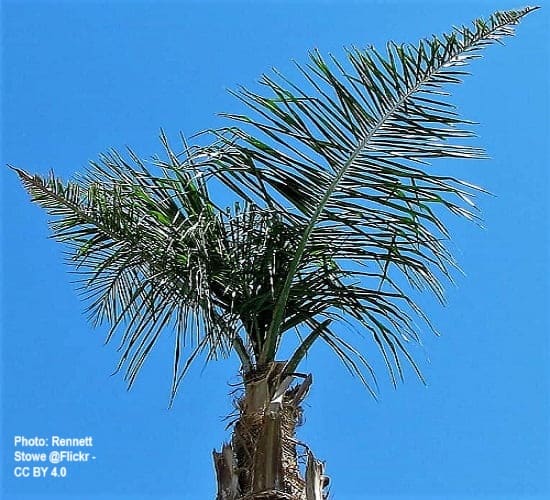
Frequently Asked Questions
About Washingtonia filifera
We've answered some repeated asks we've seen about Washingtonia filifera palm tree.
What is the difference between Washingtonia filifera and robusta?
What is the difference between Washingtonia filifera and robusta?
An easily noticed difference for Washingtonia filifera vs robusta is the height. The robusta is much taller. The robusta also has a thin trunk compared to the filifera palm tree.
What is the Washingtonia filifera used for?
What is the Washingtonia filifera used for?
Many people in arid climates love them for their tropical hints, when planting them on their properties. Recommended Palm Landscaping for them is grouping in threes with varied heights.
Where we live in Tucson Arizona, you'll see them on hotel grounds, in public parks, surrounding businesses, and lined up on islands in the middle of major streets.
They're meant to magnify the pageantry and magic of any city where they're growing.
What is the filifera meaning? Something specific?
What is the filifera meaning? Something specific?
The epithet name 'filifera' originated with the Latin word for "thread-bearing." Because there are thready areas to it. See details below in our Fun Facts Section.
Common Challenges and Solutions When Growing Washingtonia filifera
W.filifera doesn't worry much about Palm Problem Interference.
Rarely, a few issues can arise. Let's see what pests, diseases, and other concerns there could be.
Disease Protection for Washingtonia filifera
Fungal Problems
Fungus likes attacking stressed palms. Usually caused from soggy roots or pruning damage pruning.
- Pink Rot (Nalanthamala vermoesenii) attacks mostly in winter.
- Symptoms are abnormal pinkish coloring.
- Young palms are most susceptible.
- Tar Spot (Phaeochoropsis neowashingtoniae) assaults fronds. Causing Diamond Scale.
- Symptoms: black thin diamond-shaped spots. Leaves then yellow, eventually dying.
- Normally only in arid climates.
- Leaf Wilt by Fusarium proliferatum.
Prevention is the solution. Overwatering Palms is primary, but also good air circulation, and avoiding injury. Fungus can spread. Remove diseased fronds asap.
Insect Attack
Giant palm borer weevils (Dinapate wrightii) are attracted to older, stressed filiferas. Larvae are the problem, tunneling through trunks. Prevention is key. Avoid overwatering and trimming green fronds.
Fun Facts About Washingtonia Filifera
You Probably Didn’t Know
- The Washingtonia filifera palm meets up with a robusta and they have hybrid babies!
- Its role in ecosystems is providing habitat and food benefits for birds, mammals, and insects.
- We know a filifera that experienced both fire & ice! Did It Survive?
- Along leaf segments hang white, thread-like fibers. That's why it's called Cotton Palm in England.
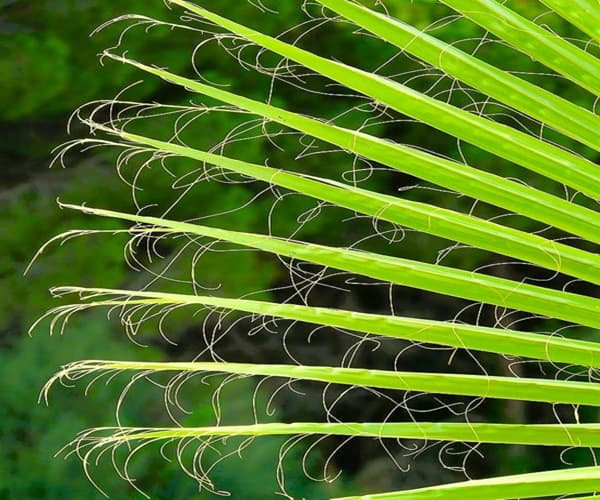 Noticeable Threads - Like White Cotton Threads
Noticeable Threads - Like White Cotton ThreadsTakeaways for the Washingtonia filifera Palm Tree
The filifera palm tree captivates with its robust size, interesting fibers, and durability.
Are you differentiating it from its Washingtonia cousin, or planning to plant a filifera? I think we'll agree there's something majestic about this sturdy palm.





